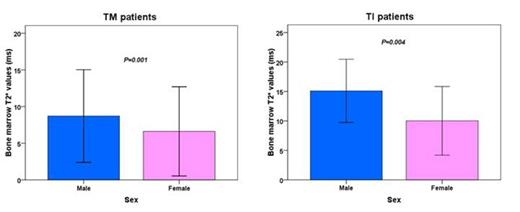Abstract
Introduction. Multiecho T2* MRI is a well-established technique for cardiac and hepatic iron overload assessment, but there are limited data on its potential to quantify iron in other organs. The aims of this study were to describe for the first time the T2* values of the bone marrow in patients with thalassemia major (TM) and intermedia (TI) and to investigate the correlation between bone marrow T2* and iron deposition in myocardium and liver.
Methods. 283 TM patients (32.25±8.28 years, 144 females) and 46 TI patients (38.30±8.73 years, 17 females) enrolled in the Myocardial Iron Overload in Thalassemia (MIOT) network underwent MRI. For the measurement of iron overload, multiecho T2* sequences were used. Bone marrow T2* values were obtained on a circular regions of interest (ROI) located in the visible body of the first or second lumbar vertebra. The left ventricle was segmented into a 16-segments standardized model and the T2* value on each segment was calculated as well as the global value. In the liver the T2* value was assessed in a single ROI defined in a homogeneous area of the parenchyma]and it was converted into liver iron concentration (LIC).
Results. Bone marrow T2* values were significantly lower in TM than in TI patients (7.65±6.29 vs 13.22±6.01 ms; P<0.0001). Bone marrow T2* values were significantly lower in females than in males in both the diseases (Figure 1), but they increased with age in a significant manner only in TM (R=0.343, P<0.0001).
In TM bone marrow T2* values were weakly associated with global heart T2* values (R=0.143; P=0.016) and negatively correlated with LIC values (R=-0.439; P<0.0001) and mean serum ferritin levels (R=-0.582; P<0.0001).
In TI no association was present between bone marrow and global heart T2* value, but bone marrow T2* values were negatively correlated with LIC values (R=-0.273; P=0.046) and mean serum ferritin levels (R=-0.569; P<0.0001).
One hundred and sixty-six TM patients (58.7%) were splenectomised and splenectomised TM patients showed significant higher bone marrow T2* values than non-splenectomised patients (9.78±6.78 ms vs 4.61±3.85 ms, P<0.0001). The difference remained significant also correcting for the age, significantly higher in splenectomised patients.
Fourty TI patients (87.0%) were splenectomised and bone marrow T2* were comparable between splenectomised and non-splenectomised TI patients (13.46±6.26 ms vs 11.61±4.05 ms, P=0.493).
Conclusions. In both TM and TI groups, males showed significantly higher T2* values. This difference may be due to the fact that the male sex is associated with severely low bone mass , which can influence the T2* values. Bone marrow T2* values were associated with heart T2* values only in TM, maybe because in TI cardiac iron overload was not common. In both TM and TI a positive correlation was found between hepatic and bone marrow siderosis. Splenectomised TM patients showed higher bone marrow T2* values, probably due to the fact that splenectomy is generally performed in patients with hypersplenism to reduce transfusion requirements. Conversely, bone marrow T2* values were comparable in splenectomised and non-splenectomised TI patients. In fact, the current indications for splenectomy in TI include growth retardation, leukopenia, thrombocytopenia, increased transfusion demand, symptomatic splenomegaly. Moreover the transfusion iron intake is significantly lower in TI.
No relevant conflicts of interest to declare.
Author notes
Asterisk with author names denotes non-ASH members.


This feature is available to Subscribers Only
Sign In or Create an Account Close Modal